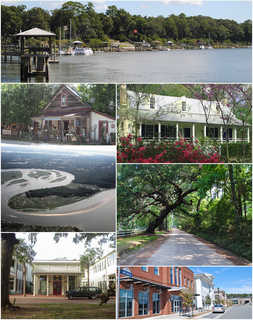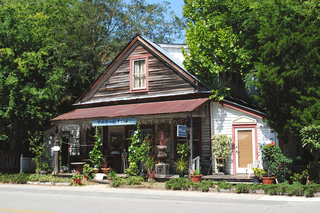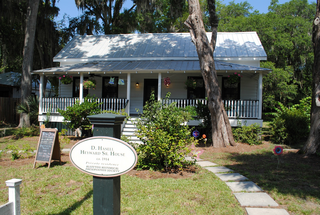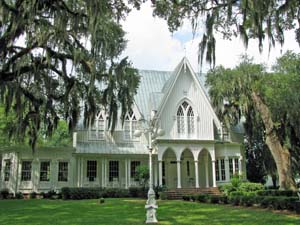The Heyward House, is located in Bluffton, South Carolina. It was built in 1841 in the early Carolina Farmhouse style brought to North America by planters from the West Indies. The north parlor and the bedroom above, were the first parts of the house built by John J. Cole and his slaves in the early 1840s as a summer home for his wife Carolina Corley and their children. John J. Coles plantation was approximately 10 miles from downtown Bluffton. His father-in-law owned Moreland Plantation, located on present day Palmetto Bluff. By 1860, Cole had more than doubled the size of the house and his family, at which time the front and side windows in the front rooms were replaced with larger windows. The original parlor windows were reused in the dining room and back bedroom. The interior is clad with wide heart pine boards.
The last remaining slave cabin in Bluffton still resides on the property.
The original unattached summer kitchen was moved to the rear of the property when a large square attached kitchen was added to the main house in the 1930s. Beetles damaged the original summer kitchen and the structure was reconstructed with original and new wood.
Following the Civil War, Mr. Cole who had contracted tuberculosis during his service, died. The Cole family sold their holdings in Bluffton and moved to Texas in 1874. Mrs. Kate Du Bois, wife of the federally appointed Post Master, purchased the property then sold it in 1882 to Mrs. George Cuthbert Heyward, Sr. and it remained in the Heyward family until its purchase in 1998 by the Bluffton Historical Preservation Society. It is now preserved and open to the public as the town's only house museum and has been designated as the official welcome center for the Town of Bluffton. [1]
- ↑ Huffman, Donna (2007). A Guide To Historic Bluffton. Bluffton Historical Preservation Society. p. 20. ISBN 978-1-60530-375-8.

Bluffton is a Lowcountry town in Beaufort County, South Carolina, United States. It is primarily located around U.S. Route 278, between Hilton Head Island and Interstate 95. The town's original one square mile area, now known as Old Town, is situated on a bluff along the May River. The population was counted by the 2010 census at 12,893, and was estimated to have swelled to 23,097 in 2018. Additionally, it is the fastest growing municipality in South Carolina with a population over 2,500, growing 882.7% between the 2000 and 2010 census. Bluffton is the fifth largest municipality in South Carolina by land area. The town is a primary city within the Hilton Head Island-Bluffton-Beaufort, SC Metropolitan Statistical Area.

The Hermitage is a historical plantation and museum located in Davidson County, Tennessee, United States, 10 miles (16 km) east of downtown Nashville. The plantation was owned by Andrew Jackson, the seventh President of the United States, from 1804 until his death at the Hermitage in 1845. Jackson only lived at the property occasionally until he retired from public life in 1837. Enslaved men, women, and children, numbering nine at the plantation's purchase in 1804 and 110 at Jackson's death, worked at the Hermitage and were principally involved in growing cotton, its major cash crop. It is a National Historic Landmark.

Long Grass Plantation is a historic house and national historic district located along what was the Roanoke River basin. In the 1950s most of it was flooded and became the Buggs Island Lake/John H. Kerr Reservoir in Mecklenburg County, Virginia. The house was built circa 1800 by George Tarry on land belonging to his father, Samuel Tarry and Long Grass Plantation encompassed approximately 2000 acres (8 km²).

Belle Meade Plantation, located in Belle Meade, Tennessee, is a historic mansion that is now operated as a museum, together with outbuildings on its 30 acres of property. In the late 19th century, the plantation encompassed roughly 5,400 acres.

Boone Hall Plantation is one of America's oldest working plantations, continually growing crops for over 320 years. The antebellum era plantation is located in Mount Pleasant, Charleston County, South Carolina, U.S.A., and listed on the National Register of Historic Places.

Bluff Hall is a historic residence in Demopolis, Alabama, United States. The original portion of the house is in the Federal style with later additions that altered it to the Greek Revival style. It was documented as part of the Historic American Buildings Survey in 1936, and added to the National Register of Historic Places in 1970. It serves as a historic house museum, with the interior restored to an 1850s appearance.

The John Brown Farm State Historic Site includes the home and final resting place of abolitionist John Brown (1800-1859). It is located on John Brown Road in North Elba near Lake Placid, New York, where John Brown moved in 1849 to lead freed slaves in farming. It was declared a National Historic Landmark in 1998. It has been managed by the state since 1896; the grounds are open to the public on a year-round basis, and tours of the house are offered in the warmer months.

Millford Plantation is a historic place located on SC 261 west of Pinewood, South Carolina. It was sometimes called Manning's Folly, because of its remote location in the High Hills of Santee section of the state and its elaborate details. Designated as a National Historic Landmark, it is regarded as one of the finest examples of Greek Revival residential architecture in the United States. The house has been restored and preserved along with many of its original Duncan Phyfe furnishings.

Riversdale, is a five-part, large-scale late Georgian mansion with superior Federal interior, built between 1801 and 1807. Also known as Baltimore House, Calvert Mansion or Riversdale Mansion, it is located at 4811 Riverdale Road in Riverdale Park, Maryland, and is open to the public as a museum.

Hope Plantation, built in 1803, is an early house built in the Palladian mode of the federal style, located on the Carolina Coastal Plain, near Windsor, North Carolina, in the United States. The plantation house was built by David Stone, a member of the coastal Carolina planter class, later Governor of North Carolina and a United States Senator. One of the finest examples of Palladian design built in timber, the manor house is slightly modified by neo-classical elements. The facade has five bays and a pedimented double portico with the original Chinese Chippendale balustrade. Crowning the house is a widow's walk with matching railing. The interior of the house displays a height and grandeur rare in the region, and is furnished with a unique collection of period furniture, art and artifacts.

Rose Hill Manor, now known as Rose Hill Manor Park & Children's Museum, is a historic home located at Frederick, Frederick County, Maryland. It is a 2 1⁄2-story brick house. A notable feature is the large two-story pedimented portico supported by fluted Doric columns on the first floor and Ionic columns on the balustraded second floor. It was the retirement home of Thomas Johnson (1732–1819), the first elected Governor of the State of Maryland and Associate Justice of the United States Supreme Court. It was built in the mid-1790s by his daughter and son-in-law.

The Newcomb–Brown Estate is located at the junction of the US 44 highway and Brown Road in Pleasant Valley, New York, United States. It is a brick structure built in the 18th century just before the Revolution and modified slightly by later owners but generally intact. Its basic Georgian style shows some influences of the early Dutch settlers of the region.

The Goodwyn-Bailey House at 2295 Old Poplar Rd. in Newnan, Georgia was built in 1835. Also known as Catalpa Plantation, it includes Greek Revival architecture. It was listed on the National Register of Historic Places in 1992. The listing included five contributing buildings and one contributing site on 100 acres (40 ha).

Seven Oaks is located in Bluffton, South Carolina. It was built in 1850. This is a two-story house with double verandas on the south and east sides and two exterior chimneys. The house is called Seven Oaks due to seven very large live oak stumps that support the house. Some of the original interior details remain; there is a visible line running east to west down the center of the northeast parlor floor indicating that an addition was made at some time.

The Store, is located in Bluffton, South Carolina. It was built in 1904. The Store sits on a large tract of land which is thought to have been the property of Mrs. John Hais Hardee, née Harriet Saussy. She was listed as the "Head of Household" and a "Planter" in both the 1850 and 1860 Census. There are no known records of who owned the property from 1865 to 1900 when it was owned briefly by the Trustees of the School District #2. In 1904, Jesse Davidore Peeples of Scotia, SC bought the property and built a store and a home beside it for his family. He had five children by his first wife, Willie Mae Stokes and ten by his second wife, Maud Estella Guilford. The house contained six bedrooms and a large sleeping porch.

The D. Hasell Heyward House, is located in Bluffton, South Carolina. It was built in 1914. This cottage was built by Nathan Crosby in 1914 for Daniel Hasell Heyward, Sr. and his wife Hattie Mae Mulligan. Constructed of pine on high brick pilings it has a wide central hallway flanked by large high-ceiling rooms with horizontal narrow pine boards on the walls and ceilings, simple moldings and tall windows front and back. A wide porch stretches the length of the front facade. The structure was restored by Lewis Hammett, Jr. Esq. and serves as his law offices.

The Dougherty Mission House is a house located at 18459 Mission Road in Peninsula Township, Michigan. It was designated a Michigan State Historic Site in 1956 and listed on the National Register of Historic Places in 2011. The house was certainly one of the first frame buildings constructed in Grand Traverse County, and is thought to be the first post and beam house constructed in Michigan's lower peninsula north of Grand Rapids.

The Judge Sebron G. Sneed House is a historic former limestone plantation house in Austin, Texas, commissioned by Judge Sebron Graham Sneed. It was likely designed by architect and general contractor, Abner Hugh Cook, co-owner of the sawmill where Sneed had purchased lumber for the construction of the house. Cook is most notable for designing the Texas Governor's Mansion in Austin.

Rose Hill Mansion is an historic site in Bluffton, Beaufort County, South Carolina, that preserves the antebellum plantation home of Dr. & Mrs. John William (1803-1868) & Caroline (1815-1864) Kirk, a wealthy planter and physician. The original Rose Hill Plantation property of 1880 acres was a wedding gift from James Brown Kirk to his eldest daughter, Caroline in 1838. Construction on the plantation house was begun in 1858. The land was used to grow cotton, rice and indigo during these years. Rice and cotton were the primary cash crops and salt was harvested from the nearby brackish creeks.

The Frank J. Hecox House, also known as the House of the Seven Gables, is a single-family home located at 3720 West Grand River Avenue near Howell, Michigan. It was listed on the National Register of Historic Places in 1994. It is a rare example of Second Empire architecture in the region.





















